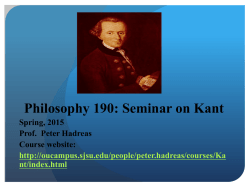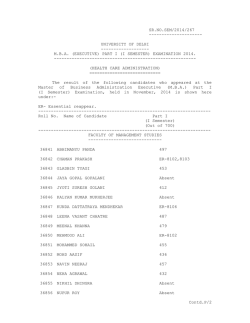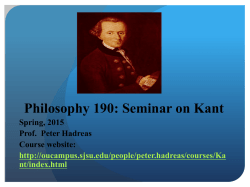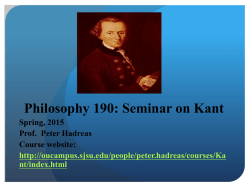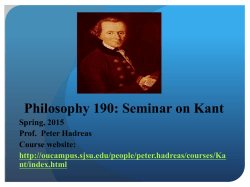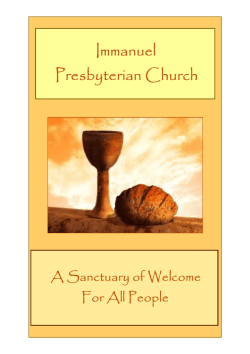
Kant, Immanuel, Critique of Pure Reason, Guyer and Wood trans.
Philosophy 190: Seminar on Kant Spring, 2015 Prof. Peter Hadreas Course website: http://oucampus.sjsu.edu/people/peter.hadreas/courses/Ka nt/index.html Immanuel Kant Some Information about Primary Texts The standard edition of Kant’s works in German is the Prussian Academy Edition, Kants gesammelte Schriften. ed. Königlich Preußischen Akademie der Wissenschaften (Berlin: Georg Reimer, subsequently Walter de Gruyter, 1910 -- ). References to this work are given in the form Ak followed by the volume number and the page number. Current Definitive Scholarly English Translation of The Critique of Pure Reason: Kant, Immanuel, Critique of Pure Reason, Guyer and Wood trans., (Cambridge: Cambridge University Press, 1998), ISBN: 0-521-65729-6. About the typographical peculiarities of our Guyer and Wood translation of The Critique of Pure Reason (1998) • Italics are used when Kant employed Latin terms. • Bold face is used for terms that Kant’s original 1781/1787 editions put in Boldface ‘Fraktur,’ the German font of Kant’s day. So last word in first paragraph of Preface A, is ‘metaphysics’ in boldface. In the original Fraktur topography it was Metaphysik. • Kant used boldface emphasis very frequently. Every page in our translation has something printed in boldface. • In the notes you’ll find often the abbreviation ‘R’. These refer to Kant’s ‘Reflexionen,’ handwritten notes that appear in Volumes 14-19 in the German Academie Edition of Kant’s works. Immanuel Kant: Recommended Secondary Texts Recommended Biography Kuehn, Manfred, Kant: A Biography, (Cambridge: Cambridge University Press, 2001). Commentaries on The Critique of Pure Reason Adorno, Theodor W., Kant’s Critique of Pure Reason, T. Tiedemann, edit, Livingstone, trans. (Stanford: Stanford U. Press, 2001) Bird, Graham, The Revolutionary Kant, (Chicago and La Salle, IL: Open Court, 2006) [879 pages] Gardner, Sebastian, Kant and the Critique of Pure Reason, (London/New York: Routledge, 1999). Immanuel Kant: Recommended Secondary Texts Kant Dictionary Caygill, Howard, A Kant Dictionary, (Oxford: Blackwell, 1995) Excellent and Influential Secondary Text on Kant’s Life and Philosophy as a Whole Cassirer, Ernst, Kant’s Life and Thought, Haden translation, (New Haven/London: Yale University Press, 1981) Immanuel Kant’s Early Years 1724-1774 Immanuel Kant (Born 22 April 1724 -- died 12 February 1804, two months before his eightieth birthday.) “On April 22 of this year [1724] Immanuel Kant was born in Königsberg. The Old Prussian Almanac associated the name ‘Emanuel’ with this date. Accordingly he was baptized ‘Emanuel.’ He would later change it to ‘Immanuel,’ thinking that this was a more faithful rendition of the original Hebrew ‘Emanuel’ or ‘Immanuel’ means God is with him.’ Kant thought that it was a most appropriate name, and he was uncommonly proud of it, commenting on its meaning even in his old age”1 1. Kuehn, Manfred, Kant: A Biography, (Cambridge: Cambridge University Press, 2001), p. 26. Immanuel Kant Early Years Kant’s father was a harness-maker who died when Kant was 22. His mother, Anna Regina, died when Kant was 13. Kant acknowledged a lasting debt to her love and instruction. She seems to have been the first to have recognized his intellectual gifts. Königsberg, where Kant resided, was the second largest city in Prussia. Unlike other German cities of the period it was not highly stratified between a patrician elite and peasants. It allowed for a certain upward social mobility. Kant went to school at the Collegium Fridericianum, a private Pietist foundation between 1732 and 1740, (He was 8 to 16) Map of Prussia before 1905 Kant’s Pietistic Background Pietism was founded in Germany by Philipp Jakob Spener (1635-1705) The Pietists regarded Christian faith not as a set of doctrinal propositions but as a living relationship with God. For Pietism, the institution of the Lutheran church was considered less important than “the church invisible”, whose membership in principle included the whole of humanity. Despite Pietism’s emphasis upon intuitive experience, its adherents laid great stress upon devotional exercises. A contemporary of Kant’s at the Collegium Fridericianum, David Ruhnken, who later became teacher of philosophy at the University of Leiden, spoke of the “pedantic and gloomy discipline of fanatics” which dominated the organization of the school.” Kant’s Reaction to his Pietistic Background Kant’s reaction: “As rector of the University of Konigsberg, he was always ‘indisposed’ when his official participation in religious observances was required.’ Kant’s one inspiring teacher at the Fridericianum was the Latin Master, Heydenreich who introduced him to a life-long love of Latin literature. Of Heydenreich’s other colleagues, Kant was later to comment: “These men could not blow into a fire any spark that lay in us for philosophy or mathematics,” and his friend is said to have answered: “But they were very good at blowing it out.”1 1. Kuehn, Manfred, Kant: A Biography, (Cambridge: Cambridge University Press, 2001), p. 50. Immanuel Kant Early Years The Collegium Fridericianum was a Pietist school where Kant was a student from the time he was eight years old until he was fifteen. “What that school offered him was solely information, and even in this respect it remained narrowly restricted. The ideal of the old Latin and academic school still reigned, especially in Prussia, and the aim of its instruction was almost exclusively directed toward the knowledge and skillful use of Latin. Even in Pomerania in 1690, an old ecclesiastical order dating from 1535 that expressly forbade the use of the German language during classes had been reinvoked: ‘The preceptors shall on all occasions address the pupils in Latin and not in German, as that is frivolous and in children scandalous and disgraceful.’”1 1. Cassirer, Ernst, Kant’s Life and Thought, trans./ J. Haden, (New Haven/London: Yale University Press, 1981), p. 14. Immanuel Kant “’I shall never forget my mother,’ he once expressed himself to Jachmann [an early biographer of Kant], ‘for she implanted in me and nurtured the first seed of the good in me; she opened my heart to the influence of Nature; she awakened and broadened my ideas, and her teaching had an enduring, beneficent effect on my life.’ His mother also seems to have been the first to recognize the boy’s intellectual gifts, and she decided, on the advice of her spiritual counselor, the theology professor and preacher Franz Albert Schultz, to guide him toward an academic education.”1 1. Cassirer, Ernst, Kant’s Life and Thought, trans./ J. Haden, (New Haven/London: Yale University Press, 1981), p. 13. Kant Enrolls at University of Königsberg 1740-1744 Kant enrolled as a theology student, but he was interested primarily in courses in mathematics and physics. He was given access to the library of his professor and studied intensively Newton and Leibniz. Reconciling Newton’s and Leibniz’s a posteriori and a priori approaches to natural science remained a overriding problem to be answered to his satisfaction finally only by The Critique of Pure Reason, published some thirty years later. Kant Manages as a Family Tutor 1746-1755 Kant was employed as a family tutor by three families. The resultant social milieu enables him to refine his social manners. He was introduced to influential quarters of East Prussian society. One tutoring position took him to Arnsdorf, some sixty miles from Königsberg. This is the farthest away he would ever travel from Königsberg in his lifetime. Kant’s Biographer, Manfred Kuehn, Means to Dispelled Some Myths about Kant’s Social Life as a Young Man “Kant was a very attractive man: ‘His hair was blond, the color of his face fresh, and his checks showed even in old age a health blush.’ His eyes were particularly arresting. As one contemporary exclaimed: ‘From where do I take the words to describe to you his eye! Kant’s eye was as if it had been formed of heavenly ether from which the deep look of the mind, whose fiery beam was occluded by a light clouds, visibly shown forth’ . . . “Yet at 5 feet 2 inches (1.57 meters) tall, and of slender build, he was neither athletic nor an imposing figure. His chest was somewhat sunken, which made breathing difficult, and he could not endure heavy physical exertion.”1 1. Kuehn, Manfred, Kant: A Biography, (Cambridge: Cambridge University Press, 2001), p. 115-6. “When Heilsberg [Kant’s friend and contemporary biographer, 1726-1806] says that Kant was ‘no great devotee (Verehrer) of the female sex,’ he did not mean that Kant looked down on women or that he was a misogynist, but rather that he was not someone for whom sexual exploits were important as a means of proving himself. ‘He felt marriage to be a desire and to be a necessity,’ but never took the final step. Once there was ‘a well brought up and beautiful; widow from somewhere else, who visited other relatives.’ Kant did not deny that she woman with whom he would have loved to share his life; but ‘he calculated income and expenses and delayed the decision from on day to the next”1 1. Kuehn, Manfred, Kant: A Biography, (Cambridge: Cambridge University Press, 2001), p. 117. Kant Becomes a Privatdocent or non-paid university Lecturer at the University of Königsberg. (1755-1770) Aided financially by a relative, Kant was able to complete his University degree at the University of Königsberg. To qualify and justify his position, he wrote three dissertations. The topics were respectively fire, the first principles of metaphysical knowledge and the advantages to natural philosophy of a metaphysics connected with geometry. Kant fame as a lecturer began to spread. As is hardly suspected by The Critique of Pure Reason, Kant’s lecturing style was witty and popular. He illustrated his topics from works of English and French literature, books of travel and geography. Kant’s Approach to Metaphysics in his Pre-Critical Works In Dreams of a Spirit-Seer Elucidated by Dreams of Metaphysics, 1766, Kant decides against the possibility of metaphysics as traditionally pursued. Problem is justifying the purchase and time devoted to reading a completely ‘empty’ work by the occultist E. Swedenborg. Metaphysics is as much a wild figment of the imagination as E. Swedenborg’s visions. But what distinguishes Kant’s skepticism from Hume’s, or any positivist, is that metaphysical speculations are perfectly meaningful. “What gives us most reason to believe in the existence of a spirit world, Kant says, is moral consciousness: obligation and the feeling of benevolence involve a feeling as of an alien will constraining us in a direction opposed to that of self-interest.” (Gardner, pp. 16-17). Kant Finally Obtains a Professorship at the University of Königsberg 1770-1797 Kant had failed twice to gain a professorship at the University of Königsberg. Finally in 1770 he obtained the chair of Logic and Metaphysics. His inaugural dissertation to this post was On the Form and Principle of the Sensible and Intelligible World. In 1781 he published the first edition of The Critique of Pure Reason. In 1785 he published the Fundamental Principles of the Metaphysics of Morals. In 1788, he published The Critique of Practical Reason in 1788 and in 1790 The Critique of Judgment. Kant’s Pre-Critical Period 1770-1781 Sebastian Gardner, following many Kantian scholars, dubs this period in Kant life, "The Silent Decade.” As Gardner writes this was a period in Kant’s career "during which Kant published next to nothing.”1 It is assumed that during this period Kant pondered the many metaphysical, epistemological, ethical and teleological impasses and inconsistencies that had arisen during from the development the Enlightenment worldview coming to a culmination during Kant’s life and from the Scientific Revolution in general. Kant’s response to the implicit cultural conflicts imbedded in the Enlightenment was The Critique of Pure Reason and the Critiques of Morals, Judgment and Religion. 1. Gardner, Sebastian, Kant and the Critique of Pure Reason, (London/New York: Routledge, 1999)., p. 11. Kant’s Fame as a philosopher and even as a sage, or perhaps an oracle spreads widely 1790-1797 By the 1790s Kant’s ‘critical philosophy’ was widely taught in most every German university. Students would journey to Königsberg as a temple of philosophy. Kant was asked to give his opinion on all sorts of questions, as if he had universal knowledge. He was asked for example to determine whether to vaccinate or not. During this period the legend of Kant taking a walk, at the ‘Philosophers Walk,’ named after him, with such a regular punctuality that people could set their watches by his walk was promulgated. He later was quoted as saying he missed this walk only once, with the publication of Rousseau’s Emile. The work so absorbed him that for several days he stayed at home. Kant’s Old Age 1797-1804 Kant retired from the university in 1797. He began a long manuscript on the conflict of faculties at the University. This work in particular considered the role of theology in a University. Kant worked on this manuscript until his death. Kant’s last years consisted in a sad decline in his intellectual and physical capacities. Perhaps it would correspond in modern pathological terms – this is the instructor's opinion -- to Alzheimer's disease. In any case, Cassirer brings evidence to the view that Kant, regardless of the decline of his intellectual acumen, demonstrated a sense of moral sensibility and goodheartedness to the end. Slides #1through 5, Portrait of Immanuel Kant in mid-life: http://www.lancaster.ac.uk/users/philosophy/courses/100/Kant003.jpg Slide #6, portrait of Kant as a young man: http://24.media.tumblr.com/tumblr_lj4frrMOpK1qiymnio1_500.jpg Slide #9, map of Prussia before 1905: http://www.college.columbia.edu/core/sites/core/files/images/Prussia_ %28political_map_before_1905%29.jpg Slide #10, German territorial losses 1919-1945: http://en.wikipedia.org/wiki/Territorial_evolution_of_Germany#mediavie wer/File:Germanborders.svg slide #24, Portrait of Immanuel Kant as old man: http://en.wikipedia.org/wiki/Immanuel_Kant#mediaviewer/File:Immanue l_Kant_(painted_portrait).jpg
© Copyright 2025
